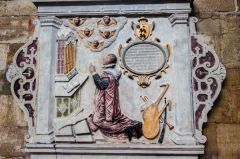
There was a Roman camp on the site of Exeter's present cathedral, and evidence of Christian worship here as early as the 5th century. A monastery grew up near the site by the 7th century, but it was not until 1050 that Exeter became a bishop's seat when the Bishop of Crediton and St Germans moved here. The first Bishop of Exeter, Leofric, was installed by Edward the Confessor, and the former minster church of St. Mary and St. Peter became the cathedral.
The Saxon church was rebuilt in 1114, but most of what remains is the result of rebuilding between 1275-1375. It seems that Bishop Bronescombe was impressed with the new cathedral at Salisbury and decided to rebuild his own church at Exeter in the new Gothic style. The Norman towers were retained from that first church, but little else.
The Lady Chapel and retrochoir were added, to be followed by the presbytery and the choir. The Early English Chapter House was built in the mid 13th century, and the nave was rebuilt in the mid 14th century, under the direction of Richard Farleigh, who was also responsible for the spire at Salisbury.

A Medieval Scandal
A famous scandal erupted at Exeter in 1283 when the Bishop and Dean engaged in a power struggle which culminated in the murder of one of the Bishop's supporters as he walked to evening services at the cathedral. King Edward I himself was called in to judge the case, and he sentenced 5 men to be executed and ordered the bishop to retire to a monastery!
The Civil War was a tumultuous period for Exeter Cathedral; the city was captured by Parliamentary forces in 1646 and the chapter disbanded. Administration of the cathedral was handed over to the city council, which decided to allow worship by two different denominations, the Presbyterians and Congregationalists.
To accommodate both groups a wall was built to divide the quire screen in two, with the Presbyterians in the quire and the Congregationalists in the nave.

During the Glorious Revolution of 1685, William of Orange held court in the Deanery before proceeding to London to take the throne as William III. In 1942 the cathedral suffered a direct hit by a German bomb; two bays in the south quire were destroyed as well as the chapel of St James and St Thomas the Martyr. The bomb damage has since been completely repaired.
The cathedral vaulting extends for an extraordinary 300 feet, making it the longest uninterrupted stone vault in Britain. The carving is wonderful, particularly in the Minstrel's gallery (look for the 14 angels, each carrying a different musical instrument) and the pulpitum.
About Cathedral
Address: Exeter,
Devon,
England, EX1 1HS
Attraction Type: Cathedral
Location: city centre, off High Street
Website: Cathedral
Location
map
OS: SX921 925
Photo Credit: David Ross and Britain Express
POPULAR POSTS
HERITAGE
 We've 'tagged' this attraction information to help you find related historic attractions and learn more about major time periods mentioned.
We've 'tagged' this attraction information to help you find related historic attractions and learn more about major time periods mentioned.
Find other attractions tagged with:
11th century (Time Period) - 14th century (Time Period) -
NEARBY HISTORIC ATTRACTIONS
Heritage Rated from 1- 5 (low to exceptional) on historic interest
Exeter, St Martin's Church - 0 miles (Historic Church) ![]()
Exeter's Underground Passages - 0.1 miles (Historic Building) ![]()
St Catherine's Almshouses & Canon's House - 0.1 miles (Historic Building) ![]()
Exeter, St Pancras Church - 0.2 miles (Historic Church) ![]()
Exeter Guildhall - 0.2 miles (Historic Building) ![]()
Exeter, St Olave's Church - 0.2 miles (Historic Church) ![]()
St Nicholas Priory - 0.2 miles (Historic Building) ![]()
Quay House - 0.3 miles (Museum) ![]()
Nearest Holiday Cottages to Cathedral:
Stoke Canon, Devon
Sleeps: 16
Stay from: £2971 - 10547
More self catering near Cathedral











